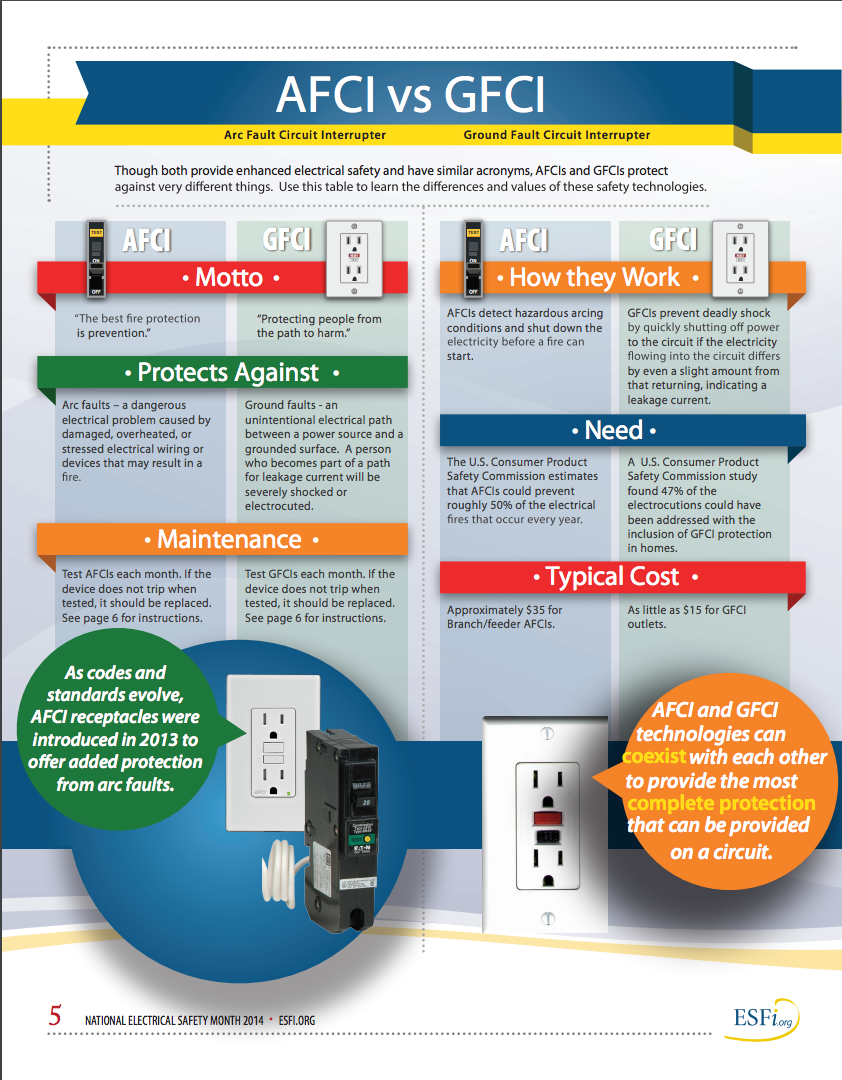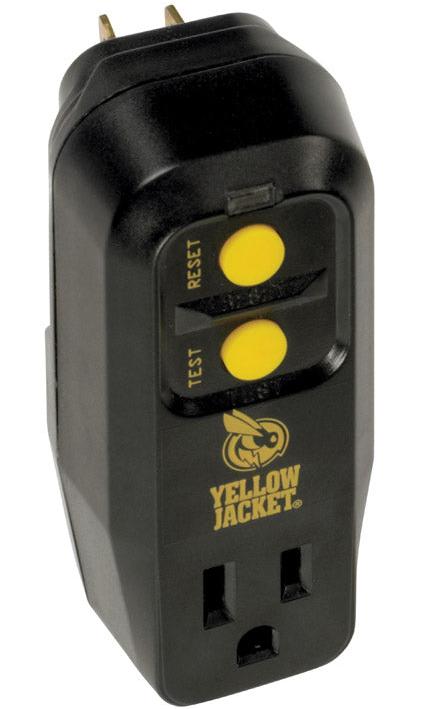Imagine this: a sudden power surge fries your expensive electronics, or a stray splash of water turns a simple outlet into a hazard. These aren’t just worst-case scenarios—they’re real threats in your home.
That’s where understanding the difference between surge protectors and GFCI outlets becomes crucial. You want to protect your gadgets and keep your family safe, but with so much jargon, where do you start? Don’t worry. This guide will break down what each of these devices does and why both could be essential for your home.
By the end, you’ll know exactly what you need to safeguard your space and your loved ones. Ready to take control of your home’s safety? Let’s dive in.
Basics Of Surge Protectors
Understanding surge protectors is essential for safeguarding your electronics. They are crucial for preventing damage from voltage spikes. A surge protector acts as a shield for your devices. It keeps them safe from unexpected electrical surges.
Functionality And Purpose
Surge protectors work by blocking excess voltage. They divert this extra power to the grounding wire. Their main role is to protect electronics from power surges. They ensure your devices receive stable electricity. Without them, devices can face serious damage.
Common Uses
Surge protectors are often used with computers. They are essential for home entertainment systems. You might find them in offices to protect equipment. Many households use them to guard kitchen appliances. They are vital for areas with frequent storms. Surge protectors can prevent costly repairs. They are a smart investment for any home.

Credit: happyhiller.com
Basics Of Gfci
Understanding the basics of GFCI is crucial for anyone keen on electrical safety in their home. You might have seen them—those outlets with two buttons in your bathroom or kitchen—but do you really know how they protect you? Think about the times you’ve plugged in your hair dryer, standing on a wet floor. That’s where GFCI steps in, offering a layer of protection that you might not even realize you need.
How Gfci Works
GFCI stands for Ground Fault Circuit Interrupter. It’s designed to prevent electrical shocks. Imagine it as a vigilant guardian, constantly monitoring the flow of electricity. If it detects an imbalance, it cuts off the power almost instantly.
This interruption happens in less than a second. It’s like having a superhero in your outlet, ready to leap into action at the first sign of trouble. The beauty of GFCI is its simplicity; it doesn’t require any special knowledge to operate, just a press of a button.
Applications In Homes
GFCI outlets are primarily installed in areas where water is present. Think kitchens, bathrooms, and outdoor spaces. These are the zones where the risk of electrical shock is higher due to moisture.
Have you ever wondered why your kitchen needs GFCI outlets? Imagine you’re cooking and accidentally spill water near your toaster. With a GFCI, you can rest assured that any potential hazard will be addressed immediately. It’s not just about safety; it’s about peace of mind.
Consider your own home. Are there areas where you feel less safe using electrical appliances? The solution might be simpler than you think. Installing GFCI outlets can transform your living space into a safer environment.
Next time you plug in your appliance, take a moment to appreciate the technology working behind the scenes. Have you checked your outlets recently? Could it be time to upgrade your home’s safety measures? These are questions worth pondering as you strive to create a secure household for you and your loved ones.
Key Differences
Surge protectors shield devices from voltage spikes, while GFCIs guard against electrical shocks. Both enhance safety but serve different purposes. Surge protectors focus on electronics, whereas GFCIs protect people in wet areas.
Understanding the key differences between surge protectors and GFCI outlets can be crucial for ensuring the safety and functionality of your electrical systems. While both offer protection, they serve very different purposes. Surge protectors shield your devices from voltage spikes, while GFCI outlets prevent electrical shocks. Knowing these differences can help you choose the right solution for your needs. Let’s dive deeper into their technical variations and installation considerations.Technical Variations
Surge protectors are designed to guard your electronics against sudden surges in electrical power. Think of them as your home’s bodyguard against unexpected voltage spikes. This is especially important if you have sensitive devices like computers or televisions. GFCI outlets, on the other hand, focus on protecting you from electrical shocks. They constantly monitor the flow of electricity and will cut off the power if they detect any imbalance. This is a lifesaver in wet areas like bathrooms and kitchens. Have you ever wondered why your hairdryer suddenly stops working when you’re in the bathroom? That’s the GFCI protecting you from potential harm. Surge protectors and GFCI outlets both play crucial roles, but their technical functions are worlds apart.Installation Considerations
When it comes to installing surge protectors, it’s as simple as plugging them into your existing outlets. They’re user-friendly and require no special tools or expertise. You can easily swap them out if you need a more robust solution as your electronics evolve. GFCI outlets are a bit more involved. Installing them requires basic electrical knowledge, or you might want to hire a professional. This ensures they’re wired correctly and can perform their protective functions effectively. Imagine the peace of mind when you know that your kitchen is safeguarded against electrical shocks. While surge protectors are a quick fix, GFCI outlets provide long-term safety in vulnerable areas. Consider your needs and the environment to make the best choice. Which one do you need more right now? The decision can make a significant impact on your home’s safety.Safety Features Compared
Surge protectors shield electronics from voltage spikes, ensuring devices stay safe during power surges. Ground Fault Circuit Interrupters (GFCIs) prevent electrical shocks, especially in wet areas, enhancing personal safety. Both devices serve distinct purposes in safeguarding homes and appliances, offering essential protection against different electrical hazards.
When it comes to safeguarding your home from electrical hazards, understanding the safety features of surge protectors and GFCI outlets is essential. Both devices play critical roles, but they serve different purposes. Comparing their safety features can help you make informed decisions on how to best protect your home and loved ones.Protection Against Electrical Surges
Surge protectors are your first line of defense against voltage spikes. These can occur when lightning strikes or when power comes back after an outage. Without proper protection, these spikes can damage your appliances and electronics. Think about a time when a sudden power surge fried your favorite gadget. A surge protector would have absorbed that extra voltage, saving your device. Investing in a quality surge protector is a small price to pay for peace of mind.Prevention Of Ground Faults
GFCI outlets, on the other hand, focus on preventing ground faults. These occur when electrical current takes an unintended path, often through water or a person. The result can be electric shock, which is especially dangerous in areas like bathrooms and kitchens. Imagine standing in a wet bathroom and touching an appliance. Without a GFCI outlet, the risk of shock is high. GFCI outlets detect these faults and cut off power instantly, keeping you safe from harm. Both surge protectors and GFCI outlets are crucial, but they address different risks. How do you decide which one is more important for your home? Understanding their unique safety features can guide you to make choices that best protect your household.Cost And Maintenance
Choosing between surge protectors and GFCIs affects cost and maintenance. Surge protectors typically require less upkeep, focusing on replacement after power surges. GFCIs demand regular testing to ensure safety, making their maintenance slightly more involved.
When choosing between surge protectors and GFCI (Ground Fault Circuit Interrupter) outlets, understanding the cost and maintenance can help you make a smart decision. Both devices are crucial for electrical safety, but they come with different price tags and upkeep requirements. Let’s break down the long-term investment and ease of maintenance for each.Long-term Investment
Surge protectors are generally less expensive upfront. You can find basic models for as little as $10, while more advanced versions with additional features might cost upwards of $50. However, they may need replacement after a major surge event, like a lightning storm. GFCI outlets cost more initially. Prices typically range from $15 to $50 per outlet. Yet, they are built to last, often for decades, without needing replacement unless they fail a test. Consider how frequently you face power surges or ground faults in your area when calculating your long-term expenses. Would you prefer to replace a device every few years, or invest more now for lasting security?Ease Of Maintenance
Surge protectors require minimal maintenance. Regularly inspect them for signs of wear or damage, like frayed cords or scorch marks. You should replace them immediately if they show any signs of damage or after a significant power event. GFCI outlets need periodic testing to ensure functionality. It’s a quick process: simply press the “Test” button, followed by the “Reset” button. If the outlet doesn’t reset, it might need replacement. This simple routine can prevent potential electrical hazards in your home. How often do you want to be involved in maintaining your electrical safety devices? These insights can guide you towards the right choice for your home and budget.
Credit: www.mycoastalace.com
Choosing The Right Option
Choosing between a surge protector and a GFCI can be confusing. Both offer safety features for electrical systems. A surge protector defends against voltage spikes. A GFCI protects from electrical shocks. Understanding your needs helps in making the right choice. Let’s explore key factors in choosing the best option for your situation.
Assessing Your Needs
Consider where you need protection. Surge protectors are ideal for electronics. They guard computers, TVs, and appliances from power surges. GFCI outlets suit wet areas. Bathrooms and kitchens benefit from GFCI safety. Think about your specific environment. Determine which areas require more attention.
Evaluate the risks present in your spaces. Electronics in living rooms face voltage spikes. Bathrooms and kitchens have water-related shock risks. Different spaces need different protection types. Identify the primary concerns for each area.
Expert Recommendations
Experts suggest surge protectors for valuable electronics. They prevent damage from sudden voltage increases. This is crucial for maintaining device longevity. GFCIs are recommended for areas near water sources. They cut power when detecting faults. This feature reduces the risk of shock. Consider these expert views to guide your decision.
Consulting an electrician can provide added insights. They can assess your home’s layout. Their advice helps tailor protection to your needs. Professional guidance ensures both safety and efficiency. Seek their expertise when uncertain.
Future Of Electrical Safety
Electrical safety is evolving rapidly, shaping the way we protect our homes. Surge protectors and GFCIs are essential tools in this landscape. With advancing technology, their roles are becoming more sophisticated. Both devices play a crucial part in preventing electrical hazards. Understanding their future is key to ensuring a safer environment.
Technological Advancements
Technology is enhancing how surge protectors safeguard devices. Modern surge protectors offer smart features that monitor power quality. They provide real-time alerts on potential risks. Advanced designs ensure better energy management. GFCIs are also benefiting from technological progress. New models detect subtle electrical faults quickly. Improved sensors increase sensitivity and reliability.
Emerging Trends
Wireless connectivity is a rising trend in surge protection. Internet of Things integration allows remote management of devices. Smart home systems use data to optimize energy use. GFCIs are embracing innovative materials for durability. Compact designs suit modern architectural styles. Increased consumer awareness drives demand for enhanced safety features.

Credit: www.amazon.com
Frequently Asked Questions
What Is The Main Purpose Of A Surge Protector?
A surge protector shields electronics from voltage spikes. It prevents damage by limiting excess voltage.
How Does A Gfci Protect You?
GFCI devices prevent electrical shock. They cut power instantly if they detect current leakage.
Can A Surge Protector Replace A Gfci?
No, they serve different purposes. A surge protector guards devices, while GFCI protects people.
Do Surge Protectors Need Regular Replacement?
Yes, over time they wear out. Check and replace every few years for safety.
Which Is More Important For Home Safety?
Both are important. Surge protectors safeguard devices. GFCIs protect against shock. Use both for full protection.
Conclusion
Choosing between surge protectors and GFCIs depends on your needs. Surge protectors guard electronics from power spikes. Essential for computers and TVs. GFCIs prevent electric shocks in wet areas. Important for kitchens and bathrooms. Understanding each helps you make smart decisions.
Safety is crucial in every home. Invest wisely to protect your family and devices. Evaluate your space and determine the best fit. Both options enhance safety in unique ways. Consider your environment and electricity usage. Make informed choices for peace of mind.
Live safely and enjoy your electrical gadgets.





